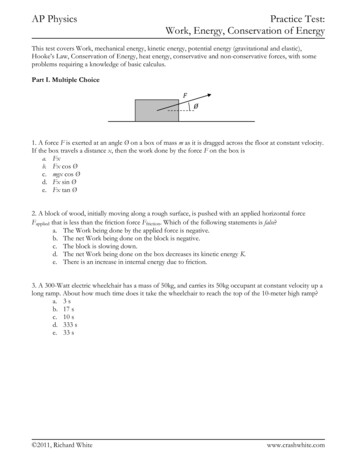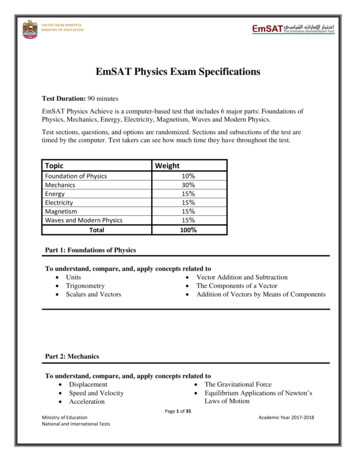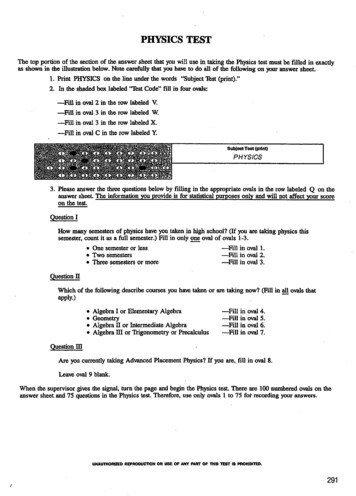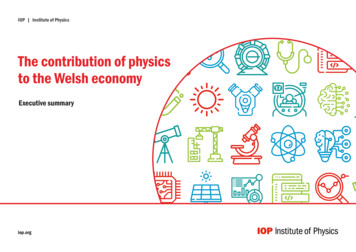
Transcription
AP PhysicsPractice Test:Work, Energy, Conservation of EnergyThis test covers Work, mechanical energy, kinetic energy, potential energy (gravitational and elastic),Hooke’s Law, Conservation of Energy, heat energy, conservative and non-conservative forces, with someproblems requiring a knowledge of basic calculus.Part I. Multiple ChoiceFØ1. A force F is exerted at an angle Ø on a box of mass m as it is dragged across the floor at constant velocity.If the box travels a distance x, then the work done by the force F on the box isa. Fxb. Fx cos Øc. mgx cos Ød. Fx sin Øe. Fx tan Ø2. A block of wood, initially moving along a rough surface, is pushed with an applied horizontal forceFapplied that is less than the friction force Ffriction. Which of the following statements is false?a. The Work being done by the applied force is negative.b. The net Work being done on the block is negative.c. The block is slowing down.d. The net Work being done on the box decreases its kinetic energy K.e. There is an increase in internal energy due to friction.3. A 300-Watt electric wheelchair has a mass of 50kg, and carries its 50kg occupant at constant velocity up along ramp. About how much time does it take the wheelchair to reach the top of the 10-meter high ramp?a. 3 sb. 17 sc. 10 sd. 333 se. 33 s 2011, Richard Whitewww.crashwhite.com
AP PhysicsPractice Test:Work, Energy, Conservation of EnergyU(r)3U02U0U00r02r03r04r0r4. The graph above represents the potential energy U as a function of position r for a particle of mass m. Ifthe particle is released from rest at position ro, what will its speed be at position 3r0?8U 0a.mb.4U 0mc.2U 0md.6U 0m e. The particle will never reach position 3r0. 5. The behavior of a non-linear spring is described by the relationship F 2kx 3 , where x is thedisplacement from the equlibrium position and F is the force exerted by the spring. How much potentialenergy is stored in the spring when it is displaced a distance x from equilibrium?1 4a.kx 2b. 6kx 2 c.1 4kx3d.1 3kx3e.2 2kx3 2011, Richard Whitewww.crashwhite.com
AP PhysicsPractice Test:Work, Energy, Conservation of EnergyPart II. Free Responseanchorm0d2danchorm0d2d6. A block of mass m rests on a rough surface, and has a light spring of spring constant k and unstretchedlength d attached to one side as shown, with the other end of the spring attached to an anchor. There is astatic coefficient of friction µs between the surface and the block, and when the block is placed to the rightat position 2d, it remains stationary on the surface. Express answers in terms of m, k, d, and fundamentalconstants. a. Draw a free-bodydiagram of the block at the time when it is located at position 2d.b.Determine the friction force acting on the block when it is located at position 2d. 2011, Richard Whitewww.crashwhite.com
AP PhysicsPractice Test:Work, Energy, Conservation of Energyanchorm0d2d3dc. The block is now moved to position 3d and released, where it remains at rest. When the block ismoved slightly past this position, the block begins to slide along the surface with a kinetic coefficientof friction µk .i. In terms of the variables given, what is the value of µs? ii. How much potential energy is stored in the mass-spring system just before the block beginsto move?iii. The block slides a total distance of d before coming to a halt again. Determine thecoefficient of kinetic friction µk . 2011, Richard Whitewww.crashwhite.com
AP PhysicsPractice Test:Work, Energy, Conservation of Energyiv. At what position does the block have its maximum velocity as it slides?v. What is the maximum velocity of the block as it slides? 2011, Richard Whitewww.crashwhite.com
AP PhysicsPractice Test:Work, Energy, Conservation of EnergyADr 20mCh 60mEB7. A roller coaster car of mass m 200 kg is released from rest at the top of a 60 m high hill (position A),and rolls with negligible friction down the hill, through a circular loop of radius 20 m (positions B, C, andD), and along a horizontal track (to position E).a. What is the velocity of the car at position B?b. Determine the velocity of the car at position C.c. Draw a free-body diagram of the car at position C. 2011, Richard Whitewww.crashwhite.com
AP PhysicsPractice Test:Work, Energy, Conservation of Energyd. Determine the velocity of the car at position D.e. Determine the force (magnitude and direction) of the track on the car at position D.f. After completing the loop, the rollercoaster car is travelling horizontally at velocity v0 and subjectedto a braking force Fbraking kv , where k is a constant, v is the instantaneous velocity of the car, andtime t is the amount of time that the braking force has been applied.i. Develop a definite integral—expressed in terms of initial velocity v0, k, m, and time t—that couldbe used to evaluate the velocity of the car along the horizontal track. ii. Solve the integral to determine an equation that could be used to calculate the horizontal velocityof the car as a function of initial velocity v0, k, m, and time t. 2011, Richard Whitewww.crashwhite.com
AP PhysicsPractice Test:Work, Energy, Conservation of Energy8. A conservative force acts in the x-direction on a particle of mass m 2.0 kg to produce a potential energycurve as shown above.a. A particle is released from rest at the 0.25 meter position.i. What is the potential energy of the particle at this position?ii. What is the velocity of this particle at x 2 meters?iii. Describe the point on the U curve at x 4m briefly, and what happens when the releasedparticle reaches this position. 2011, Richard Whitewww.crashwhite.com
AP PhysicsPractice Test:Work, Energy, Conservation of Energyiv. Does the released particle reach x 9 m? If not, explain why not. If so, describe the particle’sbehavior.b. A second particle, also of mass m 2.0 kg, is released from rest at x 9 m. Briefly describe thebehavior of this particle.c. Sketch a graph of the conservative force that produces this potential energy curve. 2011, Richard Whitewww.crashwhite.com
AP PhysicsPractice Test Solutions:Work, Energy, Conservation of Energy1. The correct answer is b. Work done by an object is calculated according to the Work formula W F x, orW Fx cos Ø. There are a couple of distractors in this problem: the mass m of the box is not needed in thesolution, and the box’s constant velocity isn’t required.The fact that the box is traveling at constant velocity implies that there is friction impeding its motion, butevidently the energy “lost” to friction is equal to the work being done by the force F, so that the net Workdone on the box by F and Ffriction 0. None of this information is necessary, though, to solve the problem.2. The correct answer is a. Statement a is false because the work done by any single agent is W Fx cos θ .Here, with the applied Force and the displacement of the box being in the same direction (orcosθ cos(0) 1), the Work being done by the applied force is positive, and goes toward increasing thebox's kinetic energy. Of course, the net, or overall, Work being done on the box has to include the force of Friction, which isacting in a direction opposite that of the box's displacement. Thus, Work done by friction is negative, whichhas the effect of converting some of the box's kinetic energy to internal energy via heat.3. The correct answer is e. The wheelchair carries a total mass of 100kg up to a height of 10m, with 300J ofWork being done by the wheelchair each second. The time for the total Work does is calculated as follows:WorkP timeWork mghtime PowerP(100kg)(10m /s2 )(10m) 10000time 33s300J /s300 4. The correct answer is c. This is a conservation of energy problem, in which we examine the relationshipbetween the particle’s potential and kinetic energies.Ui Ki U f K f3U 0 0 2U 0 12 mv 2U 0 12 mv 2v 2U 0m5. The correct answer is a. The potential energy stored in the spring is calculated using the Work integral:xf U F dxxixU 2kx 3 dx0xx41U 2k kx 44 0 2 2011, Richard Whitewww.crashwhite.com
AP Physics6.Practice Test Solutions:Work, Energy, Conservation of Energya. The block isn’t moving yet, so the force exerted by the spring to the left equals the force exerted byfriction to the right. Vectors should be labeled and drawn with lengths proportional to theirmagnitude. Some instructors wish for vectors to be drawn with their point of origin beginning at thelocation where that force is applied, and some instructors prefer that force vectors be drawnoriginating from the center of the (point) mass.FNormalFspringFfrictionFgravityb. The friction force acting on the block at this point is equal in magnitude to the force applied by thespring:Fnet maFspring F friction 0F friction kx kdc.i.The coefficient of static friction is based on the maximum force of static friction that the blocksurface can support. In this case: F friction kx k(2d)µstatic FNormal mgmg1ii. The potential energy stored in the spring is simply based on U spring kx 2 :21 2U spring kx 21 U spring k(2d) 2 2kd 22iii. The coefficient of kinetic friction can be determined by using a Conservation of Energy analysis,taking into account the potential energy of the mass-spring system at the beginning and end, aswell as the energy lost to heat in the block’s slide: U spring initial ΔE internal U spring final1 21kx i F friction d kx f 2221 21kx i µk mgd kx f 22211k(2d) 2 µk mgd kd 2223kdµk 2mg Richard White 2011,www.crashwhite.com
AP PhysicsPractice Test Solutions:Work, Energy, Conservation of Energy3 " 2kd % 3Note that this result reveals that µk ' µ , which is consistent with the principal that4 # mg & 4 xcoefficients of kinetic friction are less than coefficients of static friction.iv. The block has its maximum velocity where the slope of the velocity-time curve is 0, ie. whereacceleration is 0. At that position, the force from the spring and the force of friction are equal to each other:Fnet maFspring F friction 0kx µk FNormal kx µk mg 0where x is the displacement of the spring from its unstretched length at d. Substituting in µkfrom the problem before:kx µ k mg 0 " 3kd %kx ' mg 0# 2mg &3kx kd 023dx , relative to unstretched length at d2Relative to the origin:3d5 d d22v. Now that we know the position of the maximum velocity, we can use Conservation of Energyagain to calculate that velocity:U s initial ΔEint K U s final1 211kxi Ffriction x mv 2 kx 2f2222#d& 111 #3 &k(2d)2 µ k mg % ( mv 2 k % d ( 2' 222 2 '# 3kd & # d & 1 2 1 # 3 &21k(2d)2 %( mg % ( mv k % d (22 2 ' 2mg ' 2 ' 2Solve to get v 7.d k2 ma. This is a conservation of energy problem, with the gravitational potential energy of the car U beingconverted to kinetic energy K as the car rolls down the hill.U K1mgh mv 22v 2gh 2 9.8 60 34.3m /s 2011, Richard Whitewww.crashwhite.com
AP PhysicsPractice Test Solutions:Work, Energy, Conservation of Energyb. At position C, some of the car’s K has converted back to U.Ui K U f1mghA mvC 2 mghC2vC 2g(hA hC ) 2 9.8(60 20) 28m /sc. The free-body diagram for the car includes the only two forces acting on the car: the force ofgravity, and the force of the track which is providing the centripetal force that keeps the car movingin a circle (usually considered as a Normal force). FNormalFgravityd. The velocity of the car at position D is determined using the same technique as in (b):Ui K U f1mghA mv D 2 mghD2v D 2g(hA hD ) 2 9.8(60 40) 19.8m /se. The force of the track on the car at D can be determined by using Newton’s 2nd Law of Motion tothe circular motion:mv 2Fc rmv 2Ftrack Fg r2mvFtrack FgrHere we’re considering down (toward the middle of the circle) to be in the positive direction, andwe’re assuming that the force of the track and the force of gravity are both pointing down: the forceof gravity is providing some of the force to keep the car moving in a circle, and the force of the track will provide the remaining.In some cases, however—if the car is traveling very slowly, for example—a much smaller centripetalforce will required, to the point that the track has to provide an upwards force. We would realize thatthis was the case if we calculated a Force for the track that was negative.Continuing with our calculation:mv 2Ftrack Fgr(200)(19.8) 2Ftrack (200)(9.8) 1960N20 2011, Richard Whitewww.crashwhite.com
AP Physicsf.Practice Test Solutions:Work, Energy, Conservation of Energyi.The horizontal braking force causes the velocity of the car to decrease as a function of time t.The integral describing the car’s motion is based on applying Newton’s 2nd Law of Motion:Fnet madv kv mdtdv k vdtmdv k dtvmv dvt k v0 v 0 m dtii. Now solve the integral for v:v dvt k v0 v 0 m dt kvlnv v 0 tm klnv lnv 0 tm v ' kln& ) t% v0 ( m ktv emv0v v 0e ktm8. Potential energy can be defined only for conservative forces, and diagrams are one way of describingthose forces. The relationship between the conservative force acting on a particle, its displacement, and the dUpotential energy associated with the force is described by the equation ΔU Fx dx , or Fx .dxa.i. By examining the graph, the potential energy U is about 4 Joules.ii. Using Conservation of Energy: 𝑈! 𝐾! 𝑈" 𝐾"14𝐽 0 2𝐽 𝑚𝑣 #2 # #𝑣 . % . # 2.4𝑚/𝑠dU, there isdxno acceleration applied by the conservative force (the slope of the U curve is 0), but here, theparticle will continue moving past that position, based on the fact that it has 4 Joules of Kenergy. iii. At x 4m there is a position of unstable equilibrium. At this point, based on Fx 2011, Richard Whitewww.crashwhite.com
AP PhysicsPractice Test Solutions:Work, Energy, Conservation of Energyiv. The particle does reach the position x 9 m, and because it still has 1 Joule of K energy, it willcontinue to move to the right, even though the conservative force is no longer causing anyacceleration.b. A particle released from rest at position x 9 m will not experience any conservative force, and sowill not accelerate. It will remain at that location.c. The graph of the conservative force is effectively a graph of the negative slopes of the U-x graph.Key points to make sure are included in the Force graph are positions where U graph inflects. TheForce curve should cross the x-axis at equilibrium points (at x 2, 4, and 6 meters, as well as for x 8.5 m). Sketch in the rest of the curve based on your interpretation of the U graph. 2011, Richard Whitewww.crashwhite.com
AP Physics Practice Test: Work, Energy, Conservation of Energy 2011, Richard White www.crashwhite.com Part II. Free Response m 6. A block of mass m rests on a rough surface, and has a light spring of spring constant k and unstretched length d attached to one side as shown, with the











